This was published 1 year ago
This suburb is often called a lifeless concrete jungle. Here’s how it can flourish
The Age’s Docklands series explores what has gone wrong with Melbourne’s most maligned suburb and what could be done to fix it.
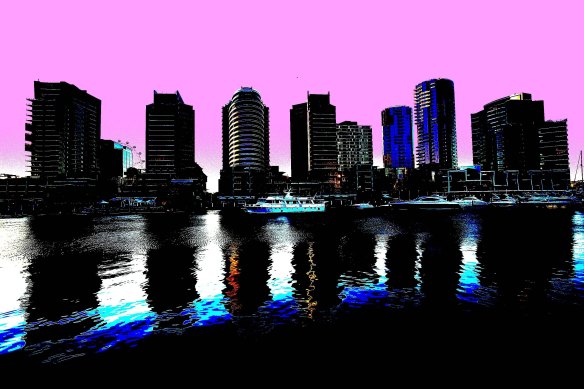
Docklands is home to about 16,000 residents, most of whom live in high-rise apartment buildings, according to ABS census data.Credit: Photo: Graham Denholm; Art Matt Davidson
Aerial images of Docklands in the 1990s show an empty, derelict wetland surrounded by rusty rectangular sheds and boats bobbing in their moorings next to empty piers.
Almost an ode to the suburb’s possibility, towering city buildings dot the skyline in the distance.
Docklands has had many incarnations over the years, but most would argue it has never reached its full potential. It was once home to Melbourne’s early underground rave scene, where wild dance parties raged inside disused warehouses and techno music blared far away from residential areas.
Long before that, it was a serene wetland filled with fish and roaming native wildlife, and a meeting place for tribes of the Kulin Nation.
It has been more than three decades since a $10 billion makeover of the former West Melbourne swamp began. The plan was to transform it into a sparkling instant city.
But it became the suburb Melbourne loves to hate.
The Age’s Docklands series explores what has gone wrong with the city’s most maligned suburb and what can be done to fix it.
Docklands’ reputation has not been helped by years of scathing critiques, and a seemingly endless series of blows has marred what was once Australia’s largest urban renewal project.
The shut-down Central Pier, a doomed Ferris wheel and a stream of businesses leaving sunlit high-rise ghost towns are all features of a suburb badly hit by the COVID-19 pandemic.
Former premier Jeff Kennett once described Docklands as a rare species of plant that takes a while to bloom. Demographers predicted it would become Melbourne’s Soho or Notting Hill, a waterfront spectacular and an urban oasis.
Swinburne University housing researcher Professor Terry Burke made a more stinging assessment in 2006: “They should blow it up and start again.”
But ask many people who live in the suburb, and they will list reasons to love it: its proximity to the city, restaurants and panoramic views of the waterfront.
Without a clear plan for the future of Docklands, pressure is mounting for a rethink and many are left wondering if the suburb will ever truly bloom.
Fed up with complaints
Standing in front of floor-to-ceiling windows overlooking the waterfront with the sunlight glistening off the water, Daniel Hibberd says he is fed up with hearing complaints about the suburb.
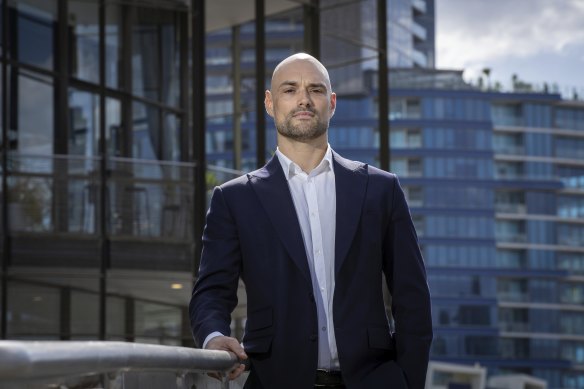
Daniel Hibberd, Docklands Chamber of Commerce president.Credit: Darrian Traynor
“Docklands is nothing but a lifeless concrete jungle that was never planned correctly,” people tell him. “It’s a freezing wind tunnel and nobody wants to visit, let alone to live there, run a business or support a community group.”
The reality, says Hibberd, who works at Quest Apartment Hotels and heads the Docklands Chamber of Commerce, is different, and while the suburb “copped an enormous whack” from the pandemic, he praises its water frontage and iconic views.
Planning expert Marcus Spiller, a founding partner at SGS Economics and Planning, agrees and does not like to think of Docklands “as some kind of moribund [area]”.
“In my opinion, Docklands has been a major economic success story for Melbourne and for the state,” says Spiller, who is a former board member of VicUrban (now Development Victoria).
He says the idea of reforming Docklands was conceived at a time when Victoria was going through a major economic shift. Its once booming manufacturing industry was ending abruptly and Melbourne was searching for a new economic model. It was turned towards industries such as banking, IT, design and finance firms, which tended to cluster in the city centre.
One advantage Melbourne had over virtually every other city in Australia, he says, was a lot of empty land close to the city centre ripe for housing development.
“It actually gave Melbourne a major economic filler, because these surging business and service firms were able to tap a very local workforce, and this literally gave Melbourne a kickstart at a time when it was going through that structural adjustment,” he says.
Yet, Docklands has been derided by Melburnians almost from the time construction began in the area in 1997. More recently, Development Victoria referred to pre-construction Docklands as a “derelict wasteland”.
A decision by the Kennett government that development should be market-driven with no government subsidy led to Docklands being parcelled into seven large precincts to make the project commercially viable.
The land was released to the market all at once in what was described as an “instant city” approach, which meant only developers with big wallets could afford to tackle Docklands, and only large-scale apartment towers and corporate offices could deliver the level of return to justify the risk.
Because planning was developer-led, public space and amenity had to be shoehorned in later. A primary school, opened in 2021, is bursting at the seams and turning to a nearby car park rooftop for playground space.
The short-term commercial thinking which dominated the formative development process and Docklands’ proximity to water also led to the suburb being pummelled by strong winds. In a 2008 report, the City of Melbourne criticised Docklands for its lack of transport and the wind-tunnel effect there.
The precinct, sitting on about 200 hectares (of which 44 hectares is water) offers a mix of uses, including residential, commercial, retail, dining and leisure.
There is no secondary school in the area, and residents have called for the land on which bulk discount supermarket Costco sits to be used for a school.
The usual hallmarks that help form the soul and community fabric of suburbs, like a public pool or recreation centre, are missing. The Docklands Neighbourhood House, which ran a homework club for primary school students and a playgroup for newly arrived young migrant families, closed in mid-2023 after the City of Melbourne stopped funding it.
“Community connection is important for any neighbourhood … but I think it is [especially] important in Docklands, because it’s a community where people have all come from somewhere else,” says former Docklands Neighbourhood Centre director Ariel Valent, who is urging a return of a permanent drop-in facility for residents.
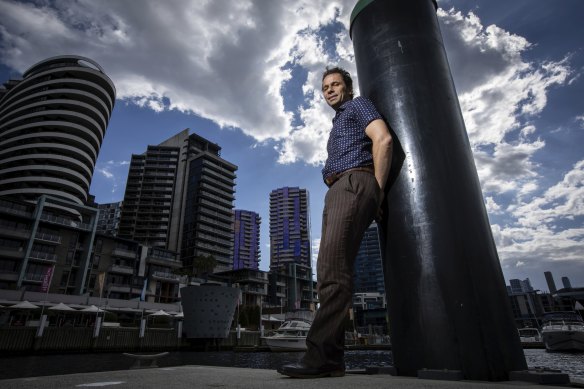
Ariel Valent used to run the now-closed Docklands Neighbourhood Centre and heads the not-for-profit group The Centre. Credit: Darrian Traynor
While Docklands was originally slated for completion by 2025, that date has been pushed out, and Minister for Development Victoria Colin Brooks says about 40 per cent of the precinct is yet to be completed.
“We know there is more to be done, but Docklands has come a long way from the industrial wasteland it was 30 years ago to the thriving employment, sports and leisure precinct it is today, and a place that thousands of Melburnians are proud to call home,” he says.
“As one of Australia’s largest urban renewal projects, we’ve invested millions to transform the area and stimulate economic activity, attracting $15 billion worth of private investment and growing a workforce that now totals more than 73,000 workers.”
Gleaming office towers built, then abandoned
Docklands is dominated by skyscrapers that house apartments and offices. Major employers include ANZ, KPMG and Medibank Private.
However, since the COVID-19 pandemic, many of the office buildings have been half-empty as more people have opted to work from home.
National Australia Bank shifted its headquarters to the CBD. Now, most of the floors of the bank’s former building in Harbour Esplanade are deserted.
Now-vacant bank office space originally leased by NAB and ANZ accounts for a combined 57,000 square metres, blowing out the amount of Australia’s sublease space. Other campus-style offices in the suburb have also been empty for some time.
Cafes and restaurants also left in droves during the pandemic, as the suburb, which relies heavily on city workers to survive, was hit hardest in Australia by coronavirus lockdowns.
But the most recent pedestrian data from the City of Melbourne shows the suburb is slowly getting back on its feet.
In March, average foot traffic detected by council monitors was 3 per cent higher than 2019 pre-pandemic levels and 20 per cent higher than March last year.
The suburb’s busiest day of the month was Sunday, March 17, coinciding with the Run for the Kids and St Patrick’s Day. The busiest time of day was between 7pm and 8pm. Fridays were the busiest weekdays, followed by Tuesdays, according to the data.
Living close to work
An increasing number of people now call Docklands home, with the most recent census data recording a population of 15,495, up from 10,964 people four years earlier.
Docklands residents are young, culturally diverse and highly educated, with a median age of 32 compared with the Victorian median age of 38, and with 49.1 per cent holding tertiary qualifications compared with 24.5 per cent in Victoria.
The census shows 22 per cent of Docklands residents are of Chinese ancestry, 15. 3 per cent of English ancestry, 13.1 per cent of Indian background and 10.1 per cent of Australian background.
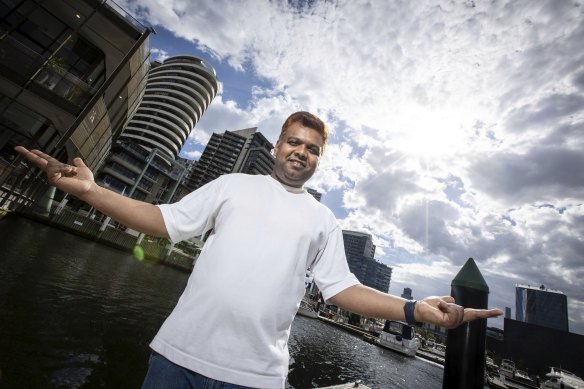
Docklands resident Anikesh Sasmal.Credit: Darrian Traynor
Anikesh Sasmal, who moved to Australia seven years ago, says employers give Indian corporate workers like him a list of suggested areas to live which usually features Docklands.
“It tells you how much time it will take to commute to your new office,” he says, recounting how he ended up in Docklands.
The government wants to increase the number of residents in Docklands, with the City of Melbourne predicting the population will increase to 22,000 over the next decade.
“Docklands plays a key role in delivering much-needed housing in Melbourne as we get on with delivering 800,000 new homes in Victoria over the next decade, with around 7500 to be built in the precinct, including a mix of build-to-sell and build-to-rent,” Minister for Development Victoria Colin Brooks says.
The City of Melbourne forecasts the Docklands population will more than double by 2041, swelling from 15,495 people to 32,431.
Patrick Fensham, Victorian head of the Planning Institute of Australia, says two-thirds of Docklands residents are renters, which poses challenges.
“Because it’s a relatively high proportion of renters, the community is a bit transient,” he says.
Fensham believes Docklands would benefit from more diversity of ownership.
“Would there be an opportunity for much more social and affordable housing so that there are people whose home it is and that there’s a cross-section of the community in there?” he asks. “Is there some opportunity for innovative home ownership tenures, or even community ownership tenures, which give people a stake in the place?”
There are some pockets of social housing in Docklands, and one resident, Lucas Hanger, is working hard to build social connections with his neighbours.
Hanger, 50, has happily lived in public housing in Docklands for 7½ years and runs free monthly gatherings for residents to learn to fish in the quay, where he regularly pulls in snapper, bream, mullet and trevally.
“It’s a social occasion. It’s all about having fun,” he says. “It brings people together because people can be lonely. It gives them a sense of belonging.”
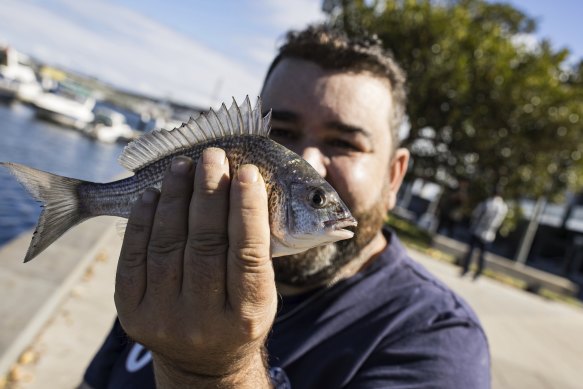
Lucas Hanger catches a fish before throwing it back in the water in Docklands.Credit: Darrian Traynor
Stunning sunsets, but attractions shut
Lord Mayor Sally Capp used to live in Docklands before relocating to Carlton and is enthusiastic about its views and proximity to the city.
“It’s got the best sunsets, because you see the sun setting over water, over the Bolte Bridge,” Capp says. “There are so many different vistas for sunsets. It’s absolutely glorious. I can’t tell you how many pictures I’ve taken of sunsets in the Docklands.”
Capp also praises the suburb’s walkability, with easy access to Southern Cross Station, Southbank, the CBD and Marvel Stadium.
She concedes the suburb’s empty cafes and shopfronts detract from the area and wants to see more activity at the ground level of the big apartment blocks and buildings.
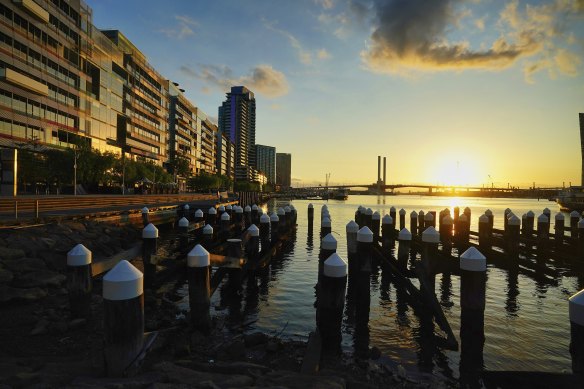
The sun sets in Docklands. Credit: Luis Enrique Ascui
“If you’ve got one shop open and everything around it is closed or empty, or is otherwise back of house, it’s really hard to create a vibe,” Capp says.
She says the City of Melbourne has limited powers over private property, but the council has partnered with landlords to provide short-term leases for empty shopfronts, sometimes at subsidised rates, along with bigger projects, such as a Docklands farmers market planned for later this year.
Action is needed, as bulk-buy supermarket Costco has announced it will close by the end of the year and the Melbourne Star Observation Wheel has sat motionless for more than two years.
The historic Central Pier has also been partially demolished after it was shut down in 2019 due to safety concerns about its structural integrity.
Now the AFL is looking to redevelop the area around Marvel Stadium, while developer Tim Gurner has proposed a $1.7 billion mega-project including 1350 apartments, hotel, retail and wellness offerings with a “self-contained biosphere-like design – the likes of which has previously only been seen in sci-fi movies”.
However, Jonathan O’Brien, founder of housing activism group YIMBY Melbourne (Yes In My Backyard), says the reason Docklands struggles is because it is a “dormitory suburb” geographically.
“There’s no reason to visit Docklands, because it’s not on the way to anywhere,” he says.
YIMBY Melbourne has measured the walkability data for Melbourne, looking at how easy it is to walk around each suburb, and on this basis, O’Brien says Docklands performs well.
There are an average of 131 restaurants within a kilometre’s walk of any given lot, which is the seventh highest level in Melbourne. The average distance from any lot to a cafe is a 302-metre walk, which is the ninth-shortest distance in Melbourne.
“Docklands gets a bad rap because it’s not a good destination,” O’Brien says. “However, on a lot of measures, it is a very good place to live.”
Making Docklands ‘more Melbourne-like’
Once the jewel in the Docklands crown, the 108-year-old Central Pier was the subject of a $42 million legal dispute involving hospitality businesses that operated there before it was evacuated and closed in 2019.
“We have got to look at what happens with Central Pier,” says Paul Guerra, head of the Victorian Chamber of Commerce. “That is a magnificent opportunity to think about what happens at this end of Melbourne differently – it should become our Darling Harbour.”
Guerra said New Year’s Eve fireworks could be displayed off the Bolte Bridge and the pier could house a music venue or conference centre to bring people back into Docklands.
Other suggestions for the pier include a fresh food market, hawker-style eateries and a university marine biology campus housed in a giant fish-shaped building.
A government spokesman said the pier’s removal was the next step in the government’s plans to revitalise the waterfront along Harbour Esplanade.
He would not comment on the details of these plans.
Planning expert Marcus Spiller says the loss of Central Pier was a “tragedy for the Docklands”, and for the suburb to truly thrive, investment in cultural infrastructure is urgently needed.
“It becomes a challenge of how do you make Docklands more Melbourne- like,” Spiller says.
He says the possibilities are endless, from increasing the use of Marvel Stadium to rethinking the mix of land uses and building more housing in areas of underutilised commercial and retail activity.
“In the next 30 years, this city will be the size of London,” he says, adding that Melbourne’s cultural infrastructure is what has always lured people to the city over places such as San Francisco, Singapore or London.
“What’s the big attraction in Fitzroy? People say there is no big attraction; it’s just Fitzroy. The same with somewhere like Williamstown. There’s no big single attraction. It’s just a neighbourhood that has a diverse range of qualities that make it a good place to be. So, rather than this catch-all sweeping solution, that’s how we need to think about Docklands.”
The Morning Edition newsletter is our guide to the day’s most important and interesting stories, analysis and insights. Sign up here.